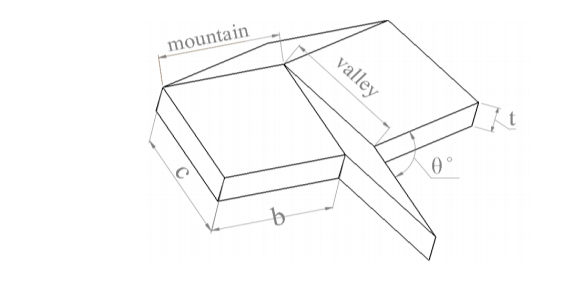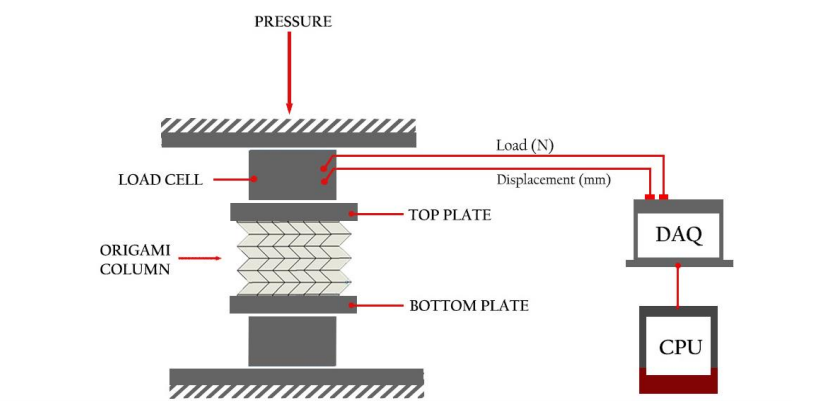In the recently published ‘Study on the compressive behavior of Miura origami column structure,’ authors I.G.R. Permana, M. Rismalia, S.C. Hidajat, A.B. Nadiyanto, and F. Triawan explored the mechanical properties of Miura-origami patterns. Because their versatility—mainly in foldability—is a source of continued fascination, the researchers chose to study the mechanical behavior when 3D printed.
An ancient Japanese art that is both a source of fascination and reverence around the world, origami is becoming increasingly more popular in engineering applications due to its potential for design in aerospace, energy (such as solar panels), robotics, and more. Some research has also reviewed its potential for energy absorption devices like automotive crash boxes. And while there is little prior knowledge of how Miura-Ori structures function under compressive load, this study investigates the mechanical properties of column structures.
“The Miura-Ori pattern is constructed with four repeating parallelograms panels which are arranged along the alternating mountain and valley folds as shown in figure 1. The size of each parallelogram for all specimens were kept constant where b = 11 mm and c = 8.66 mm. In this study, the Miura origami column was designed with three folding angle variation (θ = 70o , 90o , 110o ) and two thickness variation (t = 1 mm and 2 mm).”
3D printing samples for the research study with PLA, the authors examined variations with both angles in folding and wall thickness of prints. After that, they looked at the energy absorption capacity also. Specimens were comprised of three layers, with compression testing performed and data recorded afterward regarding load and displacement curve.
The researchers discovered that they were able to make the structure stronger by increasing the folding angle of the pattern, realizing that while a low peak force was necessary for the best energy absorption, a high mean crushing force was also required.
“However, due to its geometric constraint, the result showed that the wider folding angle could reduce the energy absorption capacity of the structure,” concluded the researchers. “Finally, the structure with 2 mm wall thickness exhibits higher yield stress, compressive modulus, and energy absorption capacity compared to the 1 mm structure. As a future work, the development of finite element model (FEM) to understand comprehensively the behavior of Miura-Ori column structure will be done.”
You might be surprised to find out how often the Japanese inspiration of folding structures and patterns like origami and 3D printing cross paths, from fabrication of metamaterials resulting in a tunable Miura-ori tribe, to expandable structures for engineering applications to mechanisms for creating robots. What do you think of this news? Let us know your thoughts! Join the discussion of this and other 3D printing topics at 3DPrintBoard.com.
[Source / Images: ‘Study on the compressive behavior of Miura origami column structure]Subscribe to Our Email Newsletter
Stay up-to-date on all the latest news from the 3D printing industry and receive information and offers from third party vendors.
You May Also Like
Kings 3D Introduces Five New 3D Printers Ahead of TCT Asia
In the weeks leading up to TCT Asia, the 3D printing scene in China is already bustling with activity and product promotion. Among the companies taking part is stereolithography (SLA)...
3D Printing Webinar and Event Roundup: April 28, 2024
In this week’s 3D Printing Webinar and Event Roundup, the Ceramics Expo is taking place in Michigan, Stratasys continues its advanced training courses, and SPE is holding a Polymer Characterization...
3D Printing Webinar and Event Roundup: April 21, 2024
It’s another busy week of webinars and events, starting with Hannover Messe in Germany and continuing with Metalcasting Congress, Chinaplas, TechBlick’s Innovation Festival, and more. Stratasys continues its advanced training...
Latest Earnings Overview for Australian 3D Printing Firms Titomic and AML3D
Australian 3D printing manufacturing firms Titomic (ASX: TTT) and AML3D (ASX: AL3) reported their financial results for the period from July to December 2023, marking the first half of their...



































